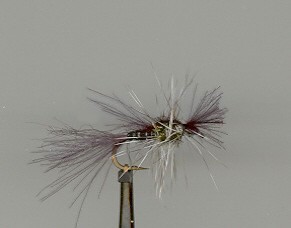
On The Fly
"Fly tying is a school from which we never graduate"
TYING NEWSSix tiers from the RFF volunteered their time to help out with the kids and bugs project in Rogue River on June 13th. It was fun and challenging showing the more than 60 students how to tie their own Wooly Worm or Wooly Bugger. Next time we will need additional tiers to be able to spend a little more time with each child. Thanks to all of you who donated materials to a worthy cause.
The Southern Oregon Fly Tiers met on Thursday, June 23rd at their new location in the Gold Hill Library. Attendance was down but not unexpected for this time of year. Rusty Randall demonstrated a new twist on the Carey Special and Loren Black showed us how to cut latex and elastic into strips for scud backs and nymph bodies. We held our monthly fly exchange and raffle. Everybody came out a winner. If you love to tie or are just a beginner, join us for an evening fun the 4th Thursday each month at 7 p.m.
 PATTERN OF THE MONTH - Hatching Midge by Randall Kaufmann
PATTERN OF THE MONTH - Hatching Midge by Randall Kaufmann
Hook Standard dry fly hook, down eye, size 14 - 20.
Tying Thread Black, 8/0
Shuck Gray or black CDC feather with a few strands of Z-Lon over the top.
Rib White thread.
Body Black dubbing, very thin.
Wing Case Gray or Black CDC feather pulled loosely over top of thorax.
Hackle Grizzly, three to four turns, slightly undersized.
Thorax Peacock herl.
Antennae Gray or black CDC tips protruding slightly over the eye of the hook.
Tying Instructions:
1) Start by wrapping a thread base from the hook shank to bend. Measure the CDC feather one shank
length and tie on flat, not on edge. This forms the trailing shuck.
2) Trim CDC butts at 1/3 shank length from the eye and bind them down with thread.
3) Tie in a few strands of Z-Lon over the shuck.
4) Tie in the ribbing thread at the front of the trailing shuck.
5) Apply a sparse amount of dubbing onto the tying thread and wrap the body to the 1/3 point.
6) Wrap the ribbing thread forward in 6 - 7 close turns over the body, tie off and trim.
7) Tie in a CDC feather at the 1/3 spot with tips pointing towards the bend.
8) Tie in the grizzly hackle, dry fly style.
9) Tie in the peacock herl and wrap it forward to form the thorax. Leave room for the head.
10) Wrap hackle forward 4 turns through the peacock thorax, tie off and trim.
11) Pull the CDC wing case forward loosely over the top of the thorax and tie off.
12) Pull all fibers at the front back away from the head area including the CDC tips. Wrap a nice tapered
head, whip finish, and cement. Remember, the head should not be tied over the CDC tips.
13) Let the CDC tips extend forward over the eye and trim to length by pinching with your fingernails.
The Hatching Midge represents a pre-adult halfway out of its nymphal shuck. It is also an excellent representation of a stillborn or "cripple" midge - one that, for some reason, becomes entangled and unable to complete the hatching into an adult. Because of the sheer abundance, midges or chironomids are usually considered the most important food source for trout, especially in lakes. They hatch nearly every day that the water is ice-free. Midges come in all sizes and colors, but black, olive and gray in sizes 16 - 22 are most common. In streams the angler should fish the Hatching Midge dead drift. On lake waters a slight twitch can imitate the struggling movement that triggers the strike. Long leaders and 5X - 7X tippets usually are the rule.
This style of fly lends itself nicely to emerging or hatching mayflies. Learn the pattern and concept, then, just vary the size and color to suit your needs. Tie some up. Give them a test flight, and let me know how you do.
TYING TIPS - Thread Ribs
This pattern uses white thread for the rib. The individual strands of most tying threads tend
to separate. The rib must be tight and narrow so twisting it a few turns with a hackle pliers will keep it
together and clean. Better yet try using machine embroidery thread for fine ribbing on dries. It's already
twisted, very strong, and a fine diameter for small flies.
Tie One On,
Dan Kellogg (you can contact me at FLYGUY@EZNORTHWEST.COM)